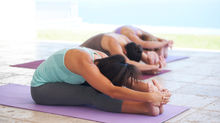The Body of a Porsche - Good Posture
“Be in control of your body and not at its mercy” - Joseph Pilates

If you owned a beautiful brand new top of the range Porsche, how would you choose to use it and look after such an expensive luxury item? Personally, I would be chomping at the bit to get behind the wheel and you can be sure that I’d keep it spotlessly clean, polished and well maintained. If I didn’t know how to look after it myself, I would check-in with the nearest Porsche specialist who could give me all the ‘know-how’ to keep it in tip top condition.
I certainly wouldn’t leave my chewing gum wrappers in it or thrash it until the engine blows. I also wouldn’t store it in a dusty old shed, unused, unloved and un-serviced.
Body Maintenance
So it surprises me that so many of us don’t treat our bodies with the same love and devotion, despite the fact that our body is perhaps the single most important possession we will ever own. Just think about that for a moment - without it, we wouldn’t even be able to drive that fantastic Porsche!
We tend to take our body for granted. We assume it will continue at full speed, day after day, with little maintenance, until finally, something breaks, slows us down or stops us in our tracks. Suddenly, we find we can’t do all the things we used to be able to do, or if we do, it hurts. Reluctantly, we head for the doctors surgery, the chiropractor or the Physiotherapist, hoping for an instant quick fix, so we can pick up where we left off.
Under the Bonnet
Just like a car, our bodies are essentially mechanical. They consist of pumps, valves and wires, housed within a skeletal frame which is supported by ligaments, joints, tendons and muscles. These supporting skeletal structures operate as a series of ‘levers and pulleys’ that enables us to move freely.
Like any mechanical structure, its efficiency relies on all the connecting parts working in unison with one another. If any one part becomes damaged or misaligned, it can increase stress and pressure on other related parts, eventually leading to muscle imbalances (weakness/tightness), inflammation and even injury.
Many people that join a Pilates class for the first time, have been referred by a physiotherapist or medical professional. Typically, they have been suffering with chronic back pain, hip pain or something similar for a long time as a result of postural problems.
So What Causes Poor Posture?
Lack of awareness and education about why and how to maintain good posture is a factor. Sometimes poor posture can develop as a result of an underlying medical condition, but more commonly, it is due to poor postural habits developed over time. Occupational demands, such as sitting hunched over a desk all day or heavy physical, repetitive work, or leading a sedentary lifestyle can all contribute to poor postural alignment.
How Can Pilates Help?
The good news is that poor posture can be rectified, through corrective postural exercises, like Pilates.
With regular Pilates practice, the body can repair and heal itself by increasing joint mobility, flexibility and core strength to alleviate symptoms and improve postural alignment. This in turn, reduces stress on the body and lowers our risk of injury. In simple terms, it means we can go about our day-day lives, free from physical discomfort or pain.
Taking the Next Step
If you’re considering Pilates and you are suffering with a chronic condition, I recommend consulting your GP or Physiotherapist in the first instance to check that Pilates is the right thing for you. The next step is to find a qualified and experienced Pilates teacher who can guide you through the movements in correct alignment, with modifications to the exercises where needed.
Want to Know More?
Keep an eye out for more Pilates blogs to come with suggested Pilates exercises that address specific postural problems. Better still, why not come along and try a BendyStretchy Pilates class for yourself!






















